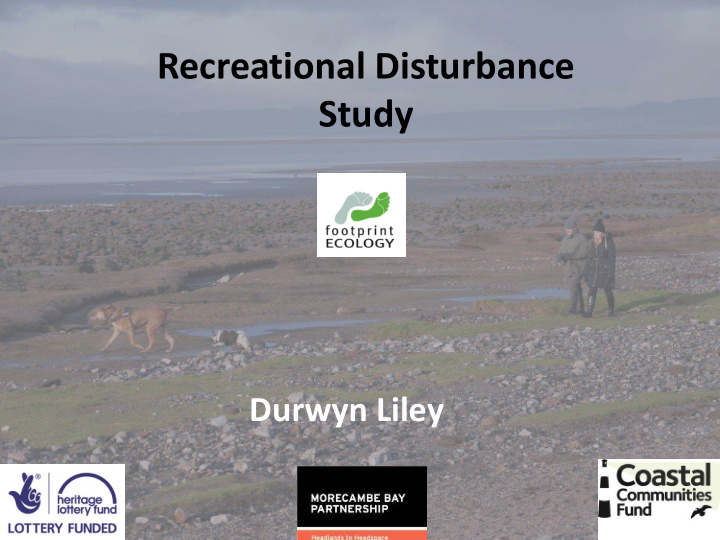



Recreational Disturbance Study Durwyn Liley
Today • Defining disturbance • Fieldwork results • Implications
Disturbance Avoidance of Suitable habitat Pop Direct Stress mortality Impact? Behavioural response
Fieldwork • Observation of people and wildlife (spring and winter): range of survey locations; 3 visits in each season, each visit recording for 1hr 30 minutes. • Systematic recording of activities, birds and responses of birds • Visitor surveys at 5 locations, involving 2 days counting people and interviews • Visits not at random, but to some extent targeted (tide/weather)
Survey areas
Summer: levels human activity • 218 events from diaries: 6.9 events per hour • Dog walking most frequent activity (55 dogs walkers with dogs off-lead, 10 on- lead) (1:6) • Snatchems busiest location.
176 Potential Disturbance Events: • East Plain v. quiet • Most major flights at Snatchems • Most birds undertaking major flight at Walney • Walney, low levels access but multiple impacts from single events • Greyhounds running extensively across mud near Chapel Island • Range of disturbance to Little Terns and breeding waders at South Walney • At Plover Scar nesting Oystercatcher and Ringed Plovers were repeatedly flushed from nest by people on seawall • Jetskis causing some flushing at Snatchems. On one visit 11 different jetskis
Response by Activity
Winter: levels human activity • 308 events from diaries • Dog walking most frequent activity (157 dogs walkers with dogs off-lead, 37 on-lead) (1:4) • Morecambe seafront busiest location.
Counts of Birds & People: winter Wader Wildfowl 600 but no high 6000 counts of 450 4500 birds where access high 300 3000 150 Total birds present 1500 0 0 0 12 24 36 48 Other 80 1 Biggar 10 Morecambe Seafront 11 Snatchems 60 12 Heysham, Heliport 13 Red Nab 15 Potts Corner 40 16 Plover Scar 17 Bolton Le Sands 20 18 Hilpsford scar 19 Inner Foulney 4 Foulney 0 6 West Plain 7 East Plain 0 12 24 36 48 9 Hest Bank Events Many low bird counts when low levels disturbance, reflects range of factors affecting distribution and abundance of birds.
Winter: activities • 72% of observed disturbance was attributed to dogs and dog walkers. • Air-borne craft, jet skis and small fast boats were activities particularly likely to cause disturbance, but relatively low level compared to dog walking. These kinds of activities are ones where marked increases in the levels/occurrence could have particular implications.
Where activity takes place West Plain, Bolton Le Sands, Hest Bank, Inner Foulney, Red Nab, Biggar All 25% + access on intertidal
Wide variation between sites in numbers of birds, habitats, types of activities, behaviour
Limitations • Snapshot • Limited survey effort • Bird use and recreation use vary with tide, weather, time of year etc. Range of factors influence both recreation and birds.
Data in total involved 14,949 potential disturbance events and the responses of 470,769 individual birds. 5 studies, 9 SPAs
Visitor Surveys 16 hours at each site, evenly split weekend and weekday and spread over daylight Site No. Interviews (%) 1 Biggar 36 (22) 9 Hest Bank 52 (32) 11 Aldcliffe 28 (17) 15 Potts Corner 26 (16) 16 Plover Scar 22 (13) Total 164
Some headline figures • 85% on short trip/day trip and visiting from home • 5% on short trip/day trip and staying with friends/family • 9% holiday makers staying away from home • 59% dog walking (most common activity at 3 sites) • 45% of visits an hour or less • 71% arrived by car • 51% visit at least weekly • 10% on first visit
Reasons for Site Choice
Median distance (all): 3.95km Median (dog walkers, from home): 3.04km
Routes Average = 3.3km
Things people like best…..
And least….
Any changes that would improve your visit….
• Piecemeal changes at individual sites unlikely Our thoughts to work • All needs ‘joining up’ • Currently relatively little infrastructure • People not aware they are visiting somewhere that’s important for wildlife – doesn’t feel or seem like a nature reserve • Pressures steadily growing: increasing pop • Large open shoreline, wide range of stakeholders
Bay-wide approach allows for forums, central communication Spreads resources (e.g. ranger time) Official branding (e.g. on signs) Can ensure consistency (messages to users)
Aerial imagery sourced from channel coast observatory
What the solutions might look like
Lower images from biotope website
Paths & people on the intertidal
Pembrokeshire National Park • Interactive maps on website • Marine code • Outdoor charter • Groups and providers sign-up to code
• Interactive map provides live information on sites where dogs are welcomed
Implementation Different threads: • IPENS • Mitigation linked to new development • Tourism • Recreation user groups • Recreation providers • Landowners • Funding streams: HLF?
Recommend
More recommend